
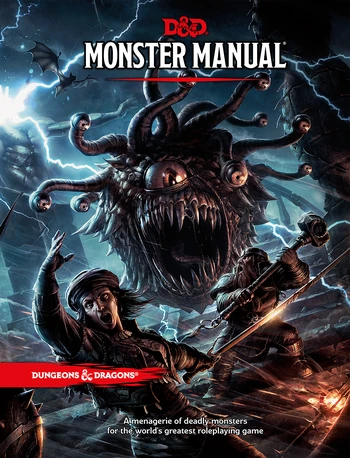
This is part two of my coverage of Dungeons & Dragon’s 5th Edition Monster Manual… both of them! Originally released in 2019 based on the original 5E Monster Manual, this review has been updated and rewritten to also cover the changes and the new monsters in the 2024 5.5E Monster Manual! I spoke about the changes between the two sub-editions of 5E in greater detail in the first part of this series, but me randomly shoving playable races into the original version of this article has always been one of the greatest regrets I had with this review series. Playable races aren’t gone, they’re just moved to their own article, probably where I’ll cover the ‘humanoid enemy template’ entries as well. And maybe the ‘appendix’ monster section would be mixed in there too, since 2024 MM moved all the interesting ones like the Awakened Tree out of the appendix.
In general, though, I’m just happy to be talking about D&D as a whole. I’ve been reading D&D sourcebooks since 4th Edition, reading comics like Order of the Stick and Goblins and being amazed that there was an ‘original’ RPG that worlds like World of Warcraft or Final Fantasy referenced. As you might have assumed based on the content of this blog, bestiaries were what caught my attention the most – 3.5th Edition had five bestiaries crammed (and I do mean crammed) to the brim with creatures, and many an evening or a commute is spent on me reading monster entries.
But I don’t think I’ve really played through a D&D game properly until 5th Edition, and the massive boom that the Critical Role live-streaming shows and its many equivalents had. The boost in popularity was really great at making the books a lot more available to find in stores, and most importantly, in finding people to play it with.
And at the end of the day, I do really love how as a function of being a role-playing game, you could do so much with world-building to serve both player and DM. I tend to favour roleplay-heavy sessions as a player, but boy, there’s just something primally satisfying about actually pulling off something cool with your dice rolls. And do D&D however you like it – many people find joy in crafting adventures or custom classes, many love to go through every different setting, many like min-maxing and finding the most optimal way to play a certain class combination, and some, like me, love D&D for the chance it gives me to talk about monsters in a manual.
[originally published in September 2019; revised in August 2025]
_________________________________________________________________

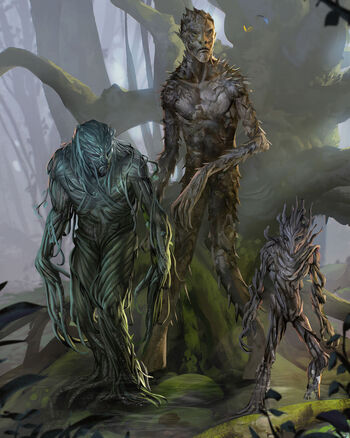
Blight
- 5.5E/5E: Small Plant; Neutral Evil; CR 1/8 (Twig Blight)
- 5.5E/5E: Medium Plant; Neutral Evil; CR 1/4 (Needle Blight)
- 5.5E/5E: Medium Plant; Neutral Evil; CR 1/2 (Vine Blight)
- 5.5E: Huge Plant; Neutral Evil; CR 7 (Tree Blight)
- 5.5E: Gargantuan Plant; Neutral Evil; CR 16 (Gulthias Blight)
(top artwork are 5E Twig Blights; followed by 5E Vine Blight, Needle Blight, Twig Blight)
We start off with a creature that debuted in 3rd Edition, and has became a quiet staple in the base Monster Manuals ever since. Plant monsters! That’s a staple in fantasy, and the Blights are the quintessential lower-level enemies for evil plants. They’ve changed a bit over the various editions, but in 5E they are bundles of plant matter that can disguise themselves as deadwood or detritus, before rising up and attacking. There’s a bit of a nice backstory, where the Blights as a whole were created when an ancient vampire called Gulthias was killed. The wooden stake used to kill Gulthias was planted by a mad druid, birthing the entire Blight race. Again, as with many of the monsters, you don’t have to specifically follow the backstory provided word-for-word, and Blights can just rise from any corrupted forest… or just spread there. Because the Gulthias-tied Blights move like a disease, uprooting and replacing plants in an area with more of their kind. It’s like parasitic plants and weeds, only on a far more destructive scale. I do like the idea of these sentient plant monsters that aren’t a typical ‘righteous wrath of Mother Earth’ like a Treant, but are a corrupting force intent on turning all plantlife in forests into more Blights.

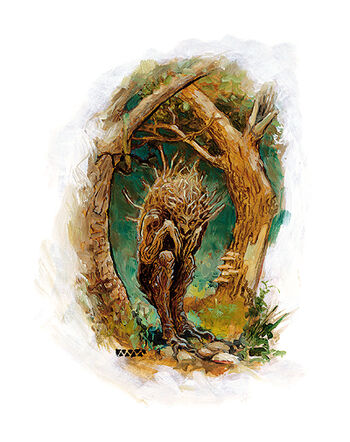
(5E Vine Blight, Needle Blight, Twig Blight; 3E Blight)
The original 5E Monster Manual gave us three variants of Blights, all pretty weak and just looking like Groot-esque humanoids made up of whatever material the are associated with. The Twig Blight is made up of wood and can hide as wood. The Needle Blight is a dude with needles and can, surprise, shoot those needles. The Vine Blight is the coolest, being made up of tendril-like vines all over his body, and is noted to be the only Blight capable of speech.
There’s always a sense of something missing after the huge, elaborate description of these Blights encroaching and corrupting forests and glades as part of a species-wide desire to just… grow. It’s the maxim of what a plant is able to do, but twisted in a hideous, corrupting way. But the stats given to us are quite underwhelming, with none of the original 5E Blights cracking CR 1, and they honestly all feel like they’re meant to be mowed down quickly.

(5.5E Vine Blight, Tree Blight, Needle Blight)
Which is where the 5.5E Monster Manual comes in, giving us three whole pages for the Blights! I have and will complain about some entries in the new Monster Manual where the lore is super-truncated, but the Blights definitely got a great expansion here. Even the existing designs got quite a bit of an upgrade. The 5.5E Twig Blights look less like a sad Groot and look positively nightmarish, being a mass of snaggly-looking skeleton made up of sharp, woody materials that just look a lot more threatening. The Vine and Needle Blights are still humanoid, but the glowing eyes and particularly the screaming maw of the Needle Blight make it a lot clearer that these are merely plant matter taking the rough approximate form of a bipedal humanoid, making them a lot more threatening-looking. 5.5E also note that you can vary your lesser blights by using different vines and whatnot, and that just customization just really appeals to me.
And we get two new variants of the Blight as well, with a much more powerful Tree Blight (which had previously shown up in Curse of Strahd and Wild Beyond the Witchlight) depicted in the artwork as looming behind the Needle and Vine Blights that do its bidding. The artwork is pretty cool, too, just having a giant tree trunk yawn open and show off a ton of fanged bark-teeth. The entirety of the trunk just splits down the middle! That’s a look for sure. It’s just a big guy that drags hapless victims into its maw with their vines and crush them.

But rather unexpectedly is the new addition of a CR 16 Gulthias Blight, actually adapting the boss ‘Gulthias Tree’ mentioned in the Blights’ original write-up. I absolutely love how fucked up the Gulthias Blight looks like, with way too many branches sprouting from a central trunk, almost like tentacles. And then you see that it’s got a mouth filled with skulls, and even more skulls just nestled in the crevasses visible from the tree’s exterior… and I’m assuming all those beady black orbs are extra eyeballs. The Gulthias Blight is the closest thing to the original ‘wood cursed by vampire blood’ idea, and I absolutely love how nasty it looks. The Gulthias Blight is the center of a Blight corruption, and has the ability to drain blood from its victims as well as shooting out seeds that grow into many lesser Blights. I love this! I love the expansion of the Blights, and it really just makes it feel like you’ve got a chunk of a horror themed campaign filled in, doesn’t it?
_________________________________________________________________


Blink Dog
- 5.5E/5E: Medium Fey; Lawful Good; CR 1/4
The Blink Dog used to be stuffed in the appendix of the original 5E Monster Manual, but it’s got half a page to himself in 5.5E! I’ve always had a soft spot for the Blink Dog. These cute canines hail from the Feywild, the realm of the faerie, and is itself a sentient fey! They can’t actually speak, but they are far more intelligent than a regular doggy. As their name implies, they can ‘blink’ or teleport for short distances. The original 5E artwork shows us a very feral-looking Blink Dog that does look like it’s likely to rip your throat out, but 5.5E goes for a much friendlier look, and adds some blue glowing runic markings to show that it’s a Fey dog.


The Blink Dog is just there to have a good time, they are totally good boys and girls, and deserve all the scritches and treats. Again, the Monster Manual is also important to house stats for potential party pets or allies, and who doesn’t want a teleporting doggy to follow you around? I suppose that’s why they changed it to look so much less rabid in 5.5E.
_________________________________________________________________

Blob of Annihilation
- 5.5E: Gargantuan Ooze (Titan); Neutral Evil; CR 23
Oh, okay, a completely brand-new monster for 5.5E, and unless I’m missing someone, this is the only one that isn’t drawn from a previous edition! One of the common criticisms of the original 5E is that it doesn’t really offer much in terms of endgame monsters, and with Animal Lord last time, I think the designers of 5.5E took this to heart and added at least one endgame boss for each of the monster categories. Blob of Annihilation here is a super-powerful ooze, a giant ooze showing to be devouring an entire hamlet in the picture. It’s got a gigantic screaming skull inside, and I really like the shades of purple and blue utilized in the artwork of this thing.
It’s also a lot more epic than just a bunch of Black Puddings or whatever that merged together. No, the Blob of Annihilation is a ‘coagulation of cosmic entropy conjoined to the remains of dead gods’. So that’s where the giant skull comes from, it’s a dead god! It’s described to be drifting a lot through ‘Wildspace’, which is the D&D cosmological term for outer space, and while only implied, I think the whole ‘cosmic entropy’ thing is just the dead-god equivalent of slime mould and rot on a regular, mortal corpse. Which I find to be gross but awesome at the same time.
The problem is, of course, if the Blob of Annihilation makes landfall on the Material Plane, either the traditional way or summoned by evil villains. The Blob of Annihilation, being, y’know, a blob, just goes around engulfing everything in its way. And with its kaiju-level size, it’s consuming towns and fortresses and forests, taking it all into its core where everything is annihilated by the entropic forces within.
A little bit of interest, however, is that magic items and the bones of gods can actually survive the Blob of Annihilation and just… stay there floating like a pearl within the cosmos’s most destructive and gloopy oyster. This has apparently led to treasure hunters and theologians either giving out quests or going themselves on expeditions to recover the treasure within the Blob, which I thought was kind of hilarious – this all-devouring mountain-sized blob with the skull of a screaming dead god is consuming a town, and you have a group of daredevil treasure hunters ready to do the D&D equivalent of bungee-jumping inside an entropic ooze to recover an important gemstone.
_________________________________________________________________

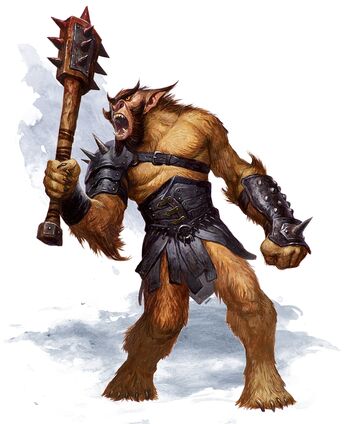
Bugbear
- 5.5E/5E: Medium Humanoid (5E) / Fey (5.5E); Chaotic Evil; CR 1 (Warrior), CR 3 (Chief/Stalker)
Neither bugs nor bears, nor do they have anything to do with either animals, Bugbears are instead goblins in D&D. Or rather, one of the three main goblinoid types, and the one that’s honestly always gets the short stick in terms of popularity or lore. ‘Bugbear’ is another word for something along the lines of boogeyman in old English, and it’s translated in D&D to… tall furry muscular goblins. Okay? They’re to goblins what ogres are to humans. They tend to be the ‘big bruiser’ types, and often are described in lore or in gameplay as being some of the elite troops alongside Hobgoblins and Goblins. With a fair chunk of lore written about the other two, Bugbears are just there as basically being something to make the encounters less static, I suppose. I love goblins, but I really can’t get myself particularly excited about a big hairy goblin.
One thing that I do like about Bugbears is that they are extremely stealthy, which is probably something drawn from their ‘boogeyman’ inspirations. The Bugbears believe it’s a gift given to them by their god Hruggek, and take pride in it. And I do like this little bit of contrast! The biggest and dumbest-looking of the goblinoids are actually specialized not just as meat-shields, but also as stealthy assassins.
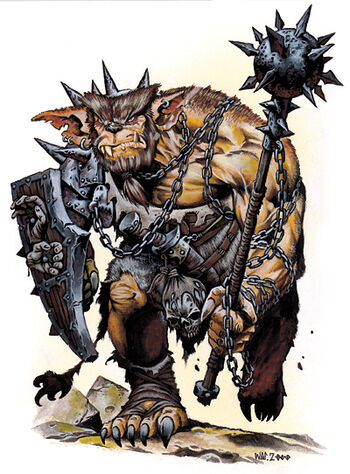
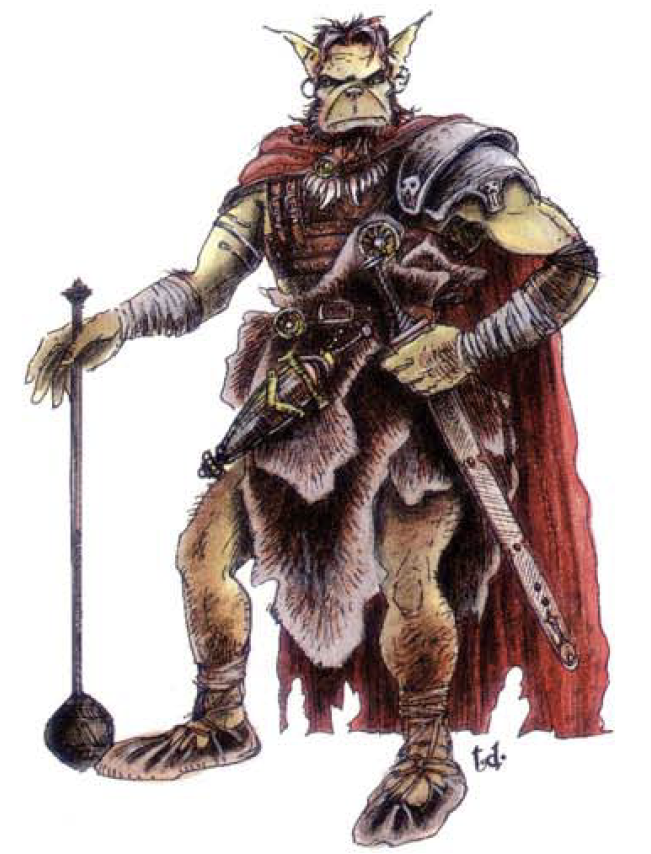
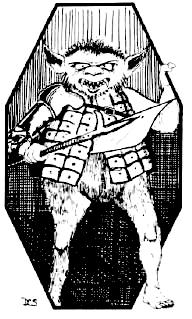
The lore about Bugbears, even in 5E, go a bit back and forth on how the Bugbears interact with their goblinoid cousins. The original 5E Monster Manual describes them as always bullying the smaller goblins, while Volo’s Guide to Monsters (which is a great ‘expansion pack’ for monster lore) describe the Bugbears as being reluctantly following hobgoblin legions so long as signs form their god show that the goblinoids are supposed to gather together. 5.5E, unfortunately, barely has lore… other than the surprising change that makes all goblinoids into fey instead of humanoids. That’s weird, isn’t it? I would welcome it if they had given us more lore, but… there really isn’t any.
I think it's probably a nice place to note that for a lot of entries that are just a single species name (like 'Bugbear' or 'Azer' or 'Kobold'), the 5.5E Monster Manual has elected to give them a rank or title. So the regular Bugbear entry has became a Bugbear Warrior in the 5.5E Manual. Which is fine! It does feel somewhat 4E-ish, but in moderation I do not think it really is a bad thing. But one rather strange change is changing the 'Bugbear Chief' to 'Bugbear Stalker'. I know Bugbears tend to defer to Hobgoblins for leadership, but surely there are individual career-minded Bugbears out there?
_________________________________________________________________

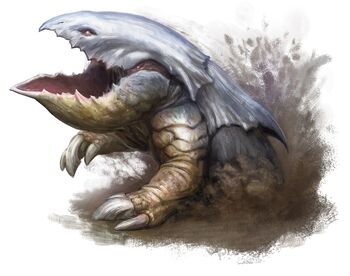
Bulette
- 5.5E/5E: Large Monstrosity; Unaligned; CR 5 (regular)
- 5.5E: Medium Monstrosity; Unaligned; CR 2 (Bulette Pup)
I do like the Bulette! Another classic monster original to D&D, the Bulette is also known as a ‘Land Shark’ and is best described as a giant-mouthed dinosaurian thing that tunnels through the ground and the erupts to chow down anyone unfortunate enough to be walking on the surface above him. Newer artworks have gone away from the ‘shark dinosaur’ concept, even eliminating the dorsal fins… which I suppose makes sense since the Bulette is supposed to be zipping through the soul like, well, a bullet. That fin would really get in the way! The 5E art gives us some nice sheen meant to resemble a whale or a shark, whereas 5.5E goes for a more ‘rock monster’ aesthetic, adding a lot more layers and texture to the head. 5.5E looks more threatening, but I do really like the sleekness and the gaping maw of 5E’s design.
A Bulette’s whole thing is that it bursts in and out of the ground… well, less like a shark but more like the stereotypical dolphin. And it just lives to eat, so it keeps bursting in and out of the ground as long as there is food on the surface. Like many subterranean monsters in D&D, they have ‘tremorsense’ that allows them to sense vibrations through rock and soil. Bulettes are noted to treat everything as food, and apparently even other Bulettes too, with 5E noting that they only come together to mate, and even after that the female will consume the male, and that they nest secretly underground since no one’s ever seen juvenile bulettes… until 2024! 5.5E gives us a brand new statblock and a cute take on it, showing a Bulette Pup! A little puppy that bursts out of the ground next to Mama Bulette, happy to cause little puppy terror… until they get killed by adventurers because it’s a little CR 2 baby monster. No!

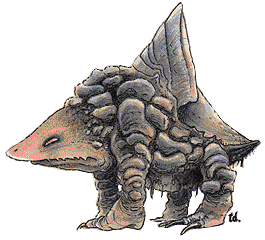
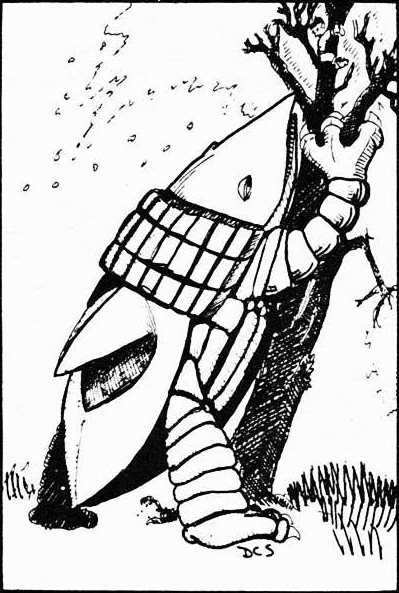
The Bulettes are noted to be the result of a “mad wizard’s experimentation”, specifically by combining snapping turtles, armadillos and demon ichor. This is a bit of a running joke for a lot of D&D’s original ‘it’s just a weird monster with no backstory’. It’s a nice, simple monster design that’s both easy to get and a distinctive look. Not every monster needs to be a Beholder or a Xorn, after all. Sometimes you just need bullet-shaped dinosaurs that burst out of the ground.
There is a cute little anecdote about the Bulette's real-world creation, where apparently a bunch of the original 'D&D original' monsters were the designers buying a bunch of ripoff Ultraman Kaiju miniatures and then extrapolating what they would be like as monsters in their medieval-based fantasy setting. I love that! The original miniature that the Bulette is based on has barely anything to do with sharks, and I like how the design ended up mutating to the Bulette we know and love.
_________________________________________________________________

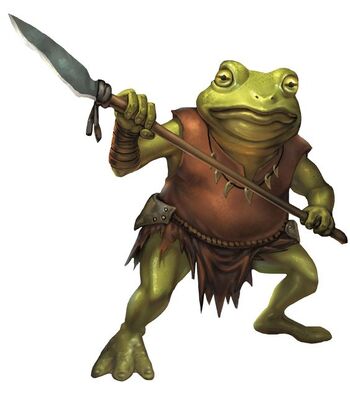
Bullywug
- 5.5E/5E: Medium Humanoid (5E) / Fey (5.5E); Neutral Evil; CR 1/4 (Warrior)
- 5.5E: Medium Fey; Neutral; CR 4 (Bog Sage)
I’ve spoken a bit about how some monsters end up being reinvented as Dungeons & Dragons moved from one edition to the next, but Bullywugs were reinvented within the game’s edition itself. The original 5th Edition Bullywug was what they had been since the game’s 1st Edition… primitive tribal toad-people. It’s a pretty simple concept, and the idea of froggy people is always a nice bit of whimsy. They’re cowardly and rely on strength of numbers, but run away when they are overpowered. Pretty nice hook for a low level adventure, and extremely memorable design as well.
The writers of the original 5th Edition Monster Manual clearly loved the Bullywug, covering a good chunk of the entire page with a lot of writeup on Bullywug culture. They raid caravans in attempts to please their leaders, and they domesticate giant toads and frogs as mounts and additional firepower against foes. But most charmingly, they consider themselves aristocracy and the rulers of the swamps, with a wacky, whimsical parody of royal etiquette and calling themselves with titles like ‘Lord of the Muck’. And among this society of frog-people they also have some fun wacky politics, with assassinations and power plays being common among these Bog Barons.

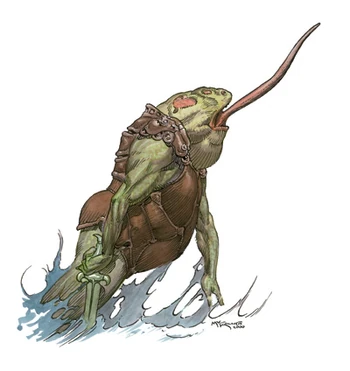
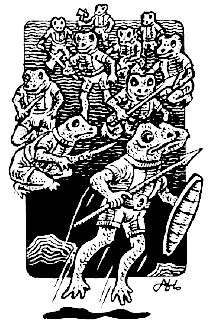
I do honestly think that the fact that the original 5E Manual had the parenthesis of ‘(bullywug)’ behind humanoid was the idea that there was going to be a Bullywug playable race at some point. Unfortunately, that never manifested. Instead, the actual playable frog-race ends up being the Grung! Who were… basically also tribal, primitive frog-people, but they are poison-arrow tree frogs with more variants, and generally a lot more written about them. It is admittedly a bit of a problem that D&D has, with multiple types of fish people, short people, giant people, devil people and whatnot that kind of overlap with each other. And it seems like the Bullywug are destined to simply be less-interesting Grung. Being playable meant that anyone looking for weird races to turn into their characters are far, far more likely to be exposed to the Grung.
Until ‘The Wild Beyond the Witchlight’, a relatively more recent adventure starring the Feywild… and lo and behold, the Bullywug got a gigantic boost as we finally get to see their silly aristocracy at play with an entire segment dedicated to a Bullywug city that tosses you deep into the wacky politics of the Soggy Court. This reinvention was ported onwards onto 5.5th Edition, which retconned the poor, forgotten Bullywugs… into being fey creatures! Which is perfect, since they always had a bit of a storybook vibe to them with their ‘strange reflection of society’ vibes. Bullywugs now dress up as weird aristocratic frog-men, which is far, far more fun and memorable to roleplay compared to the somewhat uncomfortable backwards-jungle-people-trying-to-be-royalty vibes they had before.I’ve always loved the weirdo aspects of the Bullywug and kind of disappointed that they were reduced to simply being the ‘lesser’ frog-race, but while I don’t agree with all the changes they made in 5.5th Edition, the Bullywugs are winners here!
_________________________________________________________________

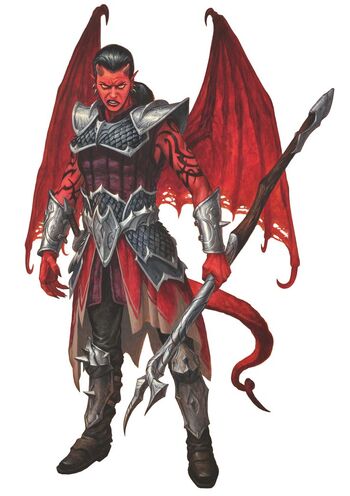
Cambion
- 5.5E/5E: Medium Fiend; Neutral Evil; CR 5
In European mythology, a ‘Cambion’ is the offspring of an incubus or succubus with a human. In D&D, this can happen with any fiend. Which leads to my comment earlier about there being a lot of ‘devil-people’ in D&D. We already have a half-fiendish player race, the Tiefling. And the attempts to explain the differences between a Cambion and a Tiefling (and many other half-fiend categories like the Tanarukk, the Forlarren, and probably many more I’m thinking of) have differed over the years. 5th Edition kept it quite simple, making Cambions being offsprings of a human and a fiend in the most, uh, traditional way. Which Tieflings can sometimes be, something that… again, isn’t quite clear. 5.5E gave a different definition, noting that Cambions are ‘former mortals’ corrupted or possessed by insidious forces, even giving a full table to roll for a Cambion’s origins. The explicit difference as given by 5.5E is that Cambions are inherently tied and remade by the Lower Planes, while Tieflings always have free will. Okay, then – it’s as good a definition as any, I suppose.
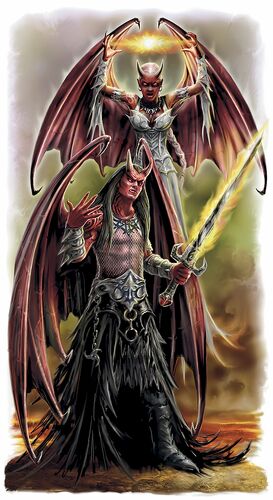

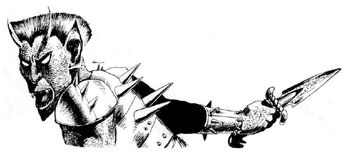
In artwork, Cambions also always have everything you’d associate with a ‘devil’ – not just horns and tails, but also the bat-wings as well. The 5E Monster Manual notes how these Cambions are always born to be evil and ‘identifies its rightful place as an overlord of mortals’ even when they were a child, and tend to have some kind of a connection to their fiendish parents.
With both 5E and 5.5E identifying different specific Cambion characters like the Spawns of Graz’zt or Iuz from the Greyhawk setting, I feel like the Cambions simply needed to be there as part of the setting when they’re honestly winged evil Tieflings instead. I think you can tell that I’m not the most impressed with these guys. But you know what? They’re all right. They’re a nice way to have fiends in a campaign at a lower level.
_________________________________________________________________

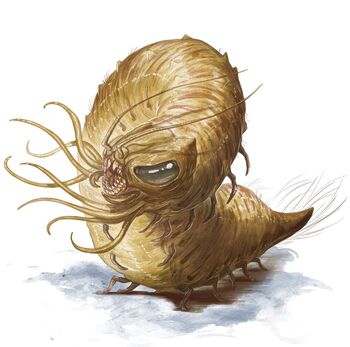
Carrion Crawler
- 5.5E/5E: Large Monstrosity; Unaligned; CR 2
Oh yeah, the Carrion Crawler! I love these guys. They’re giant monster bugs that are a nice mix of caterpillar, maggot and… a whole ton of other insects as well. The design of the Carrion Crawler has gone all over the place over the years, going from a very caterpillar-y look from the 1st Edition to something that looks like a beetle grub in the 2nd Edition, to probably one of my favourites, the very Berserk-esque, slug-like tentacled thing from 3rd and 4th Edition with a monstrous, very non-buggy mouth, more threatening tentacles and slug-eyes.
5th Edition’s Carrion Crawler tries to take aspects from all of this, although I am kind of sad that the more vibrant 3E and 4E colours are phased away to a brown, maggot-y feel. But the Carrion Crawler is now a giant grub with tiny little legs, and a giant mass of tentacles as a ‘beard’. Its head has features from a lot of different insects – elongated eyes like that of a wasp, cockroach-like antennae, sharp mandibles like a centipede… and in the center of its head are multiple rows of fangs and gums that do not look like they belong in an insect. That’s the adaptation from the 3E/4E ‘giant human mouth’, I suppose, and it’s a pretty great interpretation! The amazing artwork from 5.5E keeps up this look (with a very nice showcase of how those mouths work), but thins out the beard-tentacles, adds caterpillar bristles down the dorsal side, and makes the legs a lot more scythe-like.

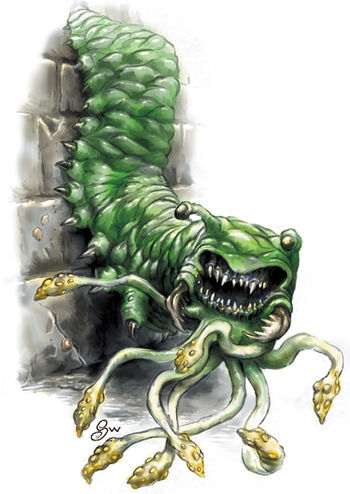

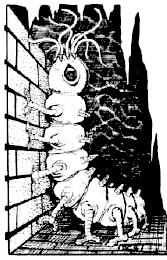
A very great design either way, and I think there’s always something to love (or to be grossed out by) in every incarnation of the Carrion Crawler. True to its name, Carrion Crawlers feed on carrion, and tend to gather in places like sewers, graveyards, marshes… and, of course, dungeons. They scuttle on walls and ceilings before ambushing their prey with their paralytic tentacles. “But they eat carrion”, you say? Well, the Carrion Crawlers know that if they kill you, yes you, you turn into carrion. Problem solved!
A lot of the older D&D monsters really do try and work with the concept of how a dungeon ecology would be like, and the Carrion Crawlers are one of the few that act as the ‘cleanup crew’ of a dungeon where many adventurers die in… but also a reason why monsters would ‘drop’ loot since Carrion Crawlers spit out all of the inorganic materials from the corpses they consume.
_________________________________________________________________


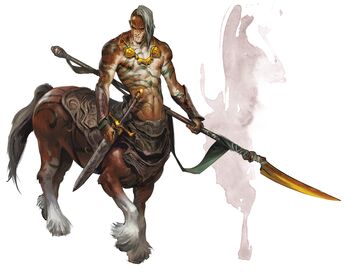
Centaur
- 5.5E/5E: Large Monstrosity (5E) / Fey (5.5E); Neutral Good; CR 2 (Trooper)
- 5.5E: Large Fey; neutral good; CR 7 (Warden)
Dungeons & Dragons obviously draws a lot from Greco-Roman mythology, and the centaurs are an easy pick. But I’ve personally never been super-enthralled by the concept of a centaur as a monster. Maybe as a playable character, or as NPCs, sure. Which is also a reason why these guys are in the books, I suppose. I don’t think D&D ever had an interesting ‘twist’ with centaurs, though, not like the way they’ve adapted a lot of classic mythological things.
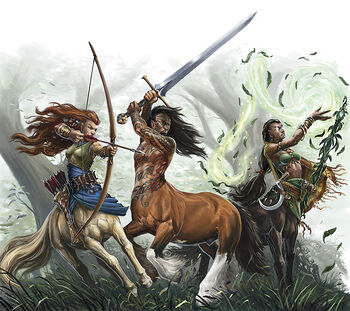
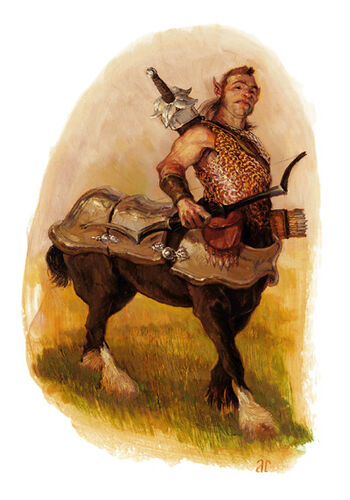

The 5th Edition take on them portrayal them as a nomadic people, going from one place to the next as hunter-gatherers that rarely settle down, going on huge migratory events and sometimes trade with the settlements they meet. It’s neat, but not exactly screaming ‘include me in your next campaign’. 5.5E tries to adapt another aspect of the centaurs from 4E that was left out by making changing them from just ‘monstrosities’ to fey, and characterizing them as defenders of nature and primeval power. Hey, it’s something, right? But otherwise they are just… just horse guys. Nothing wrong with that, I just think they could’ve been more interesting.
_________________________________________________________________

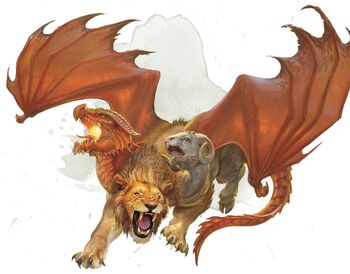
Chimera
- 5.5E/5E: Large Monstrosity; Chaotic Evil; CR 6
Another Greco-Roman monster is the Chimera – the hideous fusion of lion, goat and serpent. D&D’s Chimera has a very distinct change, however, in that instead of a serpent, it’s a dragon (Dungeons and DRAGONS, after all) that was tossed into the mix. And instead of having the head of a lion, body of a goat and a serpent head as a tail, the D&D Chimera has the heads of all three animals, and a pair of very impressive red dragon wings. While I do kind of wish we had the more goofy look of the ‘traditional’ mythological Chimera, I do admit that having the goat head bleating next to the two apex predators is equal parts charming and adds a fair bit to the creep factor.
And there’s not honestly much to say about the Chimera beyond the visual description of a multi-headed monster. It does exactly what you expect from a creature with the head of a lion, dragon and a goat… multiple attacks, and also the dragon head breathes fire. The three heads are constantly bickering (as much as a beast can bicker) but they do agree that they are territorial, and they want to feed. The dragon side also causes it to instinctively hoard treasure, which, well, adventurers like treasure! They’re intelligent enough to cruelly play with their prey, and to be ‘appeased’ by offerings of treasure.

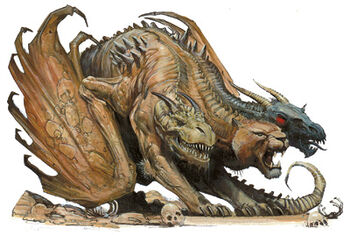

The 5th Edition Monster Manual actually talks a fair bit about the origins, where it’s not a mad wizard this time, but a mad Demon Prince… Demogorgon himself! Who shows up in other books, but Demogorgon is himself a multi-headed ‘mismatched’ creature who got bored one day and decided to fuse a bunch of creatures to make the first Chimeras. Older editions, particularly 3rd Edition, has Chimera as a ‘template’ you could mix and match with multiple creatures, giving a glorious Goat + White Dragon + Ankheg combination. That’s fun! The idea of various looks of Chimeras and variations seems to be a pretty easy theme for a dungeon, no?
_________________________________________________________________

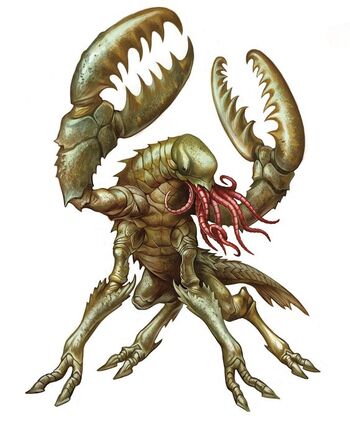
Chuul
- 5.5E/5E: Large Aberration; Chaotic Evil; CR 4
The Chuul were first introduced in 3rd Edition and has been a bit of a staple in the core bestiaries ever since. I think they realize that any Lovecraftian ‘eldritch abomination’ campaign needs some lower-level minions before you reach the Aboleths and whatnot, and the Chuul are a very nice monster of the deep! The 5E design has the Chuul have the main body structure roughly resembling a lobster, with two very nasty-looking claws. Its remaining legs are a lot sturdier and threatening-looking than a real-world crustacean, and the way the front end of the body is a bit raised actually gives the Chuul a body layout not dissimilar to a centaur. It’s got a seemingly eyeless head that terminates in a mass of tentacles as a mouth. Very Cthulhu, I approve. 5.5E gives the Chuul two prominent beady eyes, and I can’t decide which version I like more.
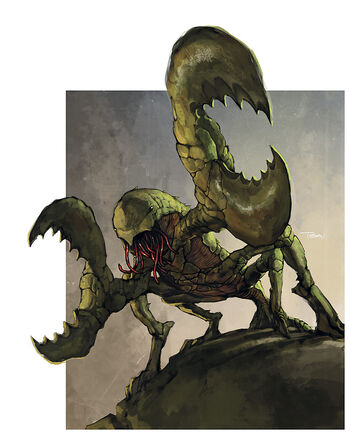
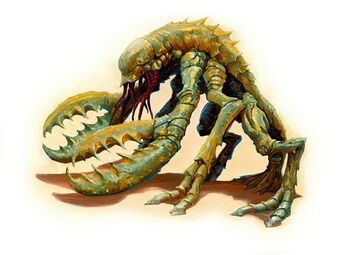
The Chuul are noted to be creations of the Aboleth, created back in the primordial ages when they used to rule the world. The Aboleths apparently created a lot of these minions, but the Chuul were the only ones that survived into modern times. Times has passed long enough that while many Chuul still serve Aboleths, many others have found new aberrant masters like beholders or illithids. Some aren’t even serving anyone, but just instinctively doing what they were originally programmed to do, collecting treasures and trying to make sense of orders that their mind tells them to follow.
The Chuul does battle with its pincers and its tentacles (which cause paralysis, of course), but it also has a passive ‘sense magic’ ability that’s always active. The idea of these Chuul being like sentries for the Aboleths that are more mobile than their fishy masters is quite an interesting one, and the 5E MM made it explicit that the Chuul were created to be amphibious and walk around on land. Their durability allows them to also just never die of old age, lying dormant if not needed and awakening when called to their dread purpose. There’s a very Shoggoth-inspired feature, and knowing what we do about some real-life creatures like the tardigrades, it’s a somewhat believable one!
_________________________________________________________________

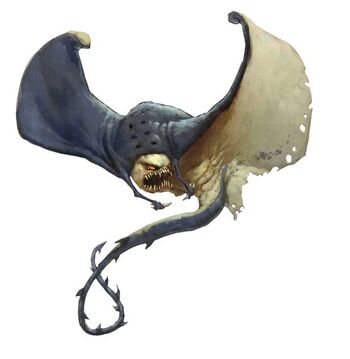
Cloaker
- 5.5E/5E: Large Aberration; Chaotic Neutral; CR 8
Older versions of D&D tend to have a bit of a bad rap for having ‘stupid’ monsters that don’t look cool and epic and whatnot. The Cloakers are one of these things, being literally a sentient evil cloak with a cartoon face in 1st and 2nd Edition. There are differing thoughts about these sorts of ‘gotcha’ enemies, but my sense is that the idea is generally well accepted, otherwise the Mimic wouldn’t be a staple of so many fantasy games. It’s just that you need to do a bit more legwork to make these things more believable instead of just making a cartoon curtain. And there’s nothing wrong with a cartoon curtain per se, but the fantasy and the flavour needs to be right.
With the Cloaker, D&D decided to go and make it into something a bit more inspired by real-life creatures, specifically manta rays. And that redesign in 3rd Edition apparently was popular enough that it stuck – the ‘cloak’ moniker is still there, with many descriptions of the Cloaker looking like a leathery cloak at rest, but for the most part the idea is that these guys just hide with their camouflaged hide on ceilings and walls of caves and dungeons, before they attack. Large rays actually have adapted to have the ventral and dorsal side be optical camouflages, which definitely makes it a nice animal to have the Cloaker be based on.

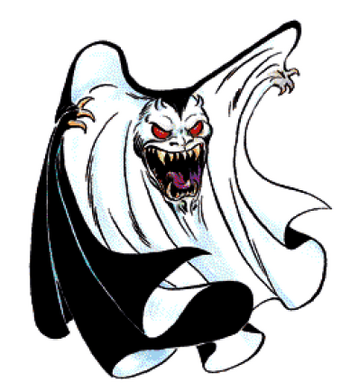
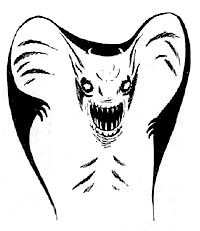
The ‘manta-ness’ of the Cloakers have changed quite a bit over the years, and the original 5E put a snarling demon-face on the center of a body that’s more or less a spikier manta ray. 5.5E tries to make it a bit more distinct, giving it a blue hue, adding more spikes, and making the little horns look more like tiny t-rex hands. The artwork of the 5.5E version also has the Cloaker flying through the sky, and I like the idea of Cloakers that have adapted to various biomes and changed their appearances to fit.
The Cloakers are aberrations that normally live in the Underdark, and are ambush predators. Their clear gimmick attack is, of course, engulfing and wrapping around their prey and attempt to smother them. However, they’re also explicitly intelligent creatures and have a fair number of abilities that – creating illusionary phantasms, and making haunting moans that strike fear. Anyway, I do like this – I don’t agree with a lot of the ‘super serious’ po-faced reinventions of some of the older D&D monsters, but I think they found something quite cool with the Cloakers.
For the confusing bit about bugbear changes, I believe Mordenkainen or Witchlight state that goblinods were from the feywilds, then magibluyet was a dick and plucked a bunch of them to be his army.
ReplyDeleteMaybe he's running out of cannon fodder and the few distinction is becoming more known lol.
No, I do get the in-universe explanation. Maglubiyet the goblin god is a conqueror, and that extends to pantheons -- he conquered the pantheons of the goblins, hobgoblins and bugbears, converting them all into goblinoids, which explains why the three of them look so different.
DeleteBut I'm just kind of confused from a out-of-universe developmental point of view is all.